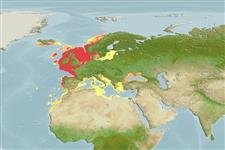| Native range | All suitable habitat | Point map | Year 2100 |

|
| This map was computer-generated and has not yet been reviewed. |
| Eutrigla gurnardus AquaMaps Data sources: GBIF OBIS |
Length at first maturity
Lm 18.8, range 24 - ? cm
Utilização humana
Pescarias: espécies comerciais
Phylogenetic diversity index
(Ref. 82805)
PD50 = 1.0000 many relatives (e.g. carps) 0.5 - 2.0 few relatives (e.g. lungfishes)
Nível Trófico
(Ref. 69278)
3.9 ±0.0 se; Based on diet studies.
Resiliência
(Ref. 69278)
Médio, tempo mínimo de duplicação da população 1,4 - 4,4 anos (K=0.16; tm=3-4; tmax=16; Fec=200,000)